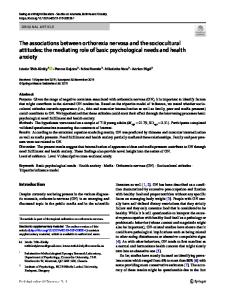Basic psychological need satisfaction across the retirement transition: Changes and longitudinal associations with depre
- PDF / 771,176 Bytes
- 16 Pages / 595.276 x 790.866 pts Page_size
- 98 Downloads / 275 Views
ORIGINAL PAPER
Basic psychological need satisfaction across the retirement transition: Changes and longitudinal associations with depressive symptoms Andreas Stenling1 · Georg Henning2 · Pär Bjälkebring3,4 · Susanne Tafvelin1 · Marie Kivi3 · Boo Johansson3 · Magnus Lindwall3,5
© The Author(s) 2020
Abstract Drawing on self-determination theory, the present study examined how satisfaction of the basic psychological needs (autonomy, competence, and relatedness) changes across the retirement transition and how need satisfaction was related to depressive symptoms across the retirement transition. Participants (N = 2655) were drawn from the HEalth, Ageing and Retirement Transitions in Sweden (HEARTS) study. Latent growth curve modeling showed that autonomy need satisfaction increased across the retirement transition, whereas competence and relatedness remained relatively stable. Higher need satisfaction was related to less depressive symptoms at baseline, however, pre-retirement need satisfaction was not a statistically significant predictor of subsequent changes in depressive symptoms (or vice versa) across the retirement transition. At the within-person level, higher than usual need satisfaction at a specific time point was related to less than usual depressive symptoms. Need satisfaction may be an important factor to consider across the retirement transition and need satisfying activities prior, during, and after the transition may ease peoples’ adjustment to retirement. Keywords HEARTS study · Need satisfaction · Retirement · Self-determination theory · Well-being
Introduction Retirement is a major life course event in adult life. How people adjust to the transition from work to retirement has gained increased interest in psychological research in recent years (e.g., Aspinwall 2005; Barbosa et al. 2016; Bye and Pushkar 2009; Custers et al. 2014; Wang and Shi 2014). Electronic supplementary material The online version of this article (https://doi.org/10.1007/s11031-020-09854-2) contains supplementary material, which is available to authorized users. * Andreas Stenling [email protected] 1
Department of Psychology, Umeå University, SE‑901 87, Umeå, Sweden
2
German Centre of Gerontology, Berlin, Germany
3
Department of Psychology & AgeCap, University of Gothenburg, Gothenburg, Sweden
4
Department of Psychology, The Ohio State University, Columbus, OH, USA
5
The Swedish School of Sport and Health Sciences, Stockholm, Sweden
A better understanding of how people adjust to retirement is important because it provides information about how to improve the quality of postretirement life, besides the opportunity to understand how people adjust to internal (i.e., physical and psychological aging) and external (i.e., lifestyle and societal norms) challenges in later life (Wang et al. 2011). Researchers often rely on various well-being outcomes to understand how people adjust to retirement life (Wang 2012). When measured longitudinally across the retirement transition and into post-retirement, cha
Data Loading...











